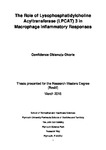The Role of Lysophosphatidylcholine Acyltransferase (LPCAT) 3 in Macrophage Inflammatory Responses
| dc.contributor.supervisor | Jackson, Simon | |
| dc.contributor.author | Okorie, Confidence Obianuju | |
| dc.contributor.other | School of Biomedical Sciences | en_US |
| dc.date.accessioned | 2019-02-19T13:32:09Z | |
| dc.date.available | 2019-02-19T13:32:09Z | |
| dc.date.issued | 2015 | |
| dc.identifier | 10476660 | en_US |
| dc.identifier.uri | http://hdl.handle.net/10026.1/13316 | |
| dc.description.abstract |
Sepsis is the systemic response to infection and is characterised by the presence of Severe Inflammatory Response Syndrome (SIRS) in addition to a documented or presumed infection. It is an important reason for admission into the Intensive Care Unit (ICU), the leading cause of death in non-coronary ICU’s and one of the most common causes of death among hospitalized patients. It affects 18 million people worldwide each year with over 7.3 million fatalities. Molecules such as endotoxin, the Lipopolysaccharide (LPS) present in the outer membrane of Gram-negative bacteria, are key factors in the pathogenesis of sepsis. The activation of macrophages with LPS results in rapid changes in the expression of genes encoding cytokines and other inflammatory mediators. The excessive, prolonged and unregulated activation of macrophages in sepsis leads to a vicious cascade of the release of these inflammatory mediators that augments the inflammation to the detriment of the host. The Lysophosphatidylcholine acyltransferase (LPCAT) enzymes, expressed in monocytes and macrophages among other cells and tissues have been found to be very important in the regulation of membrane phospholipids’ fatty acid composition and together with phospholipase A2 enzyme, control the phospholipids’ re-modelling process in the plasma membrane and are required for the inflammatory function of macrophages. There have been indications that the induction of LPCAT 3 results in the priming of macrophages for subsequent eicosanoid secretion. Investigating the activity of this enzyme, particularly, its contribution to inflammatory processes in these cells informed this research. A murine macrophage cell line, RAW 264.7, was used in this study. To investigate the effect of LPCAT 3 on LPS induced inflammatory responses, LPCAT3 was silenced using the RNA interference (RNAi) technology and this was confirmed using reverse transcription coupled real time PCR. Macrophage stimulation was achieved using LPS. The optimization of reference genes was considered important for the standardisation of results as the conventional practice of utilising one reference gene for result optimisation has been found unreliable. This was done using real time PCR, as was the comparative quantitation of two cytokines: Tumour Necrosis Factor alpha (TNF-alpha) and Interleukin-10 (IL-10). The protein expression of TNF-alpha was analysed using ELISA. Results from the experiments showed the reference genes GAPDH, RPL13A and CASC3 to be the most stably expressed in the PCR analysis of the expression of the genes of interest. Normalization of PCR results was done using the normalization factor generated by the geometric mean of the cycle threshold values of these reference genes. A strong relationship between LPCAT 3 silencing and a statistically significant reduction in the LPS-induced expression of the pro-inflammatory cytokine TNF-alpha was also observed while this relationship with regards to IL-10 was inconclusive. In conclusion, LPCAT 3 is involved in the inflammatory responses of macrophages and its silencing results in a significant reduction in the LPS-induced expression of TNF-alpha. Further investigations into the mechanisms of action of this enzyme would further strengthen the possibility of the emergence of novel and specific anti-sepsis therapies in the near future. | en_US |
| dc.language.iso | en | en_US |
| dc.publisher | Plymouth University | en_US |
| dc.subject | Sepsis | en_US |
| dc.subject | LPCAT3 | en_US |
| dc.subject | Inflammation | en_US |
| dc.subject | Macrophage | en_US |
| dc.subject | Cytokine | en_US |
| dc.subject | LPS | en_US |
| dc.subject.classification | ResM | en_US |
| dc.title | The Role of Lysophosphatidylcholine Acyltransferase (LPCAT) 3 in Macrophage Inflammatory Responses | en_US |
| dc.type | Masters | en_US |
| plymouth.version | publishable | en_US |
| dc.rights.embargoperiod | No embargo | en_US |
| dc.type.qualification | Masters | en_US |
Files in this item
This item appears in the following Collection(s)
-
01 Research Theses Main Collection
Research Theses Main


